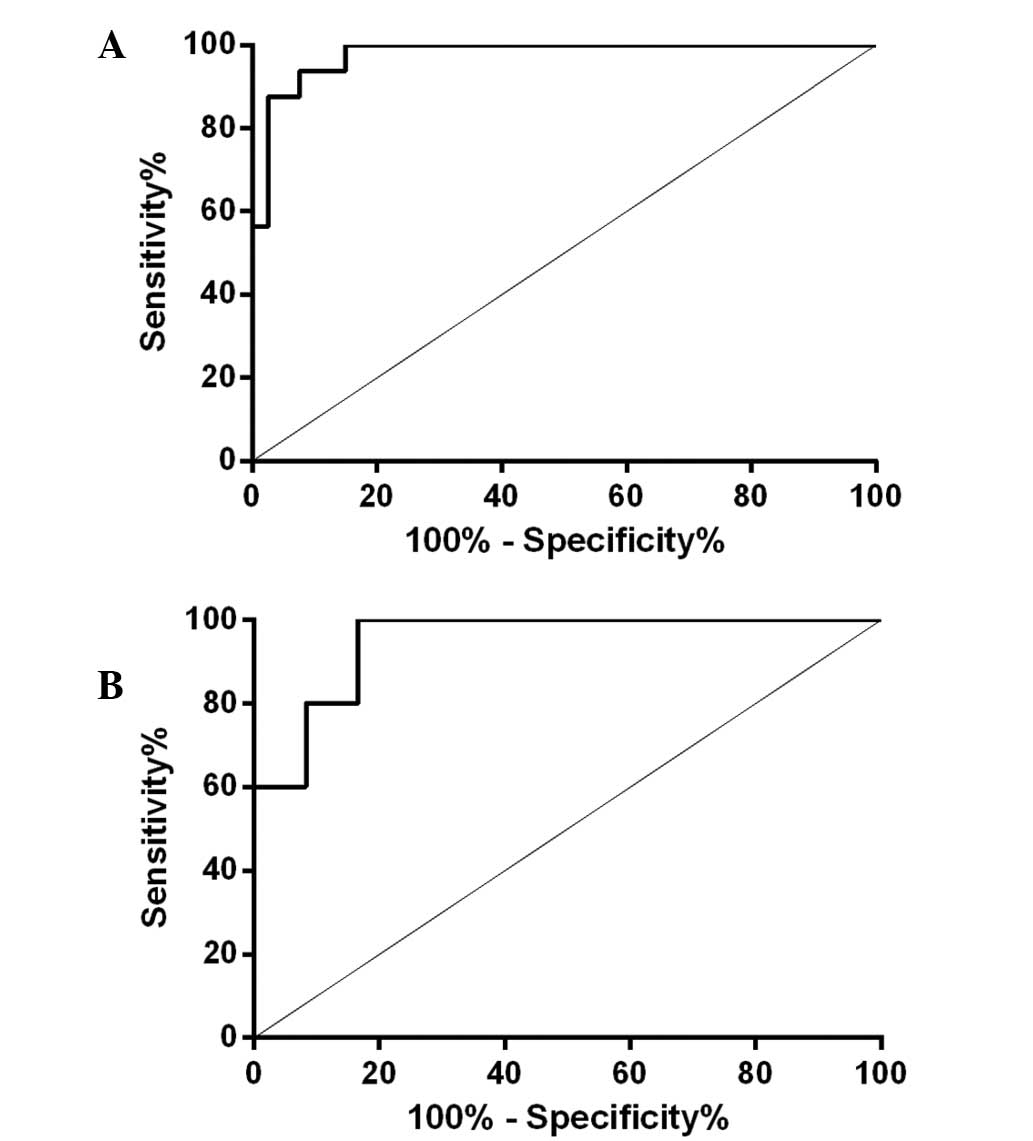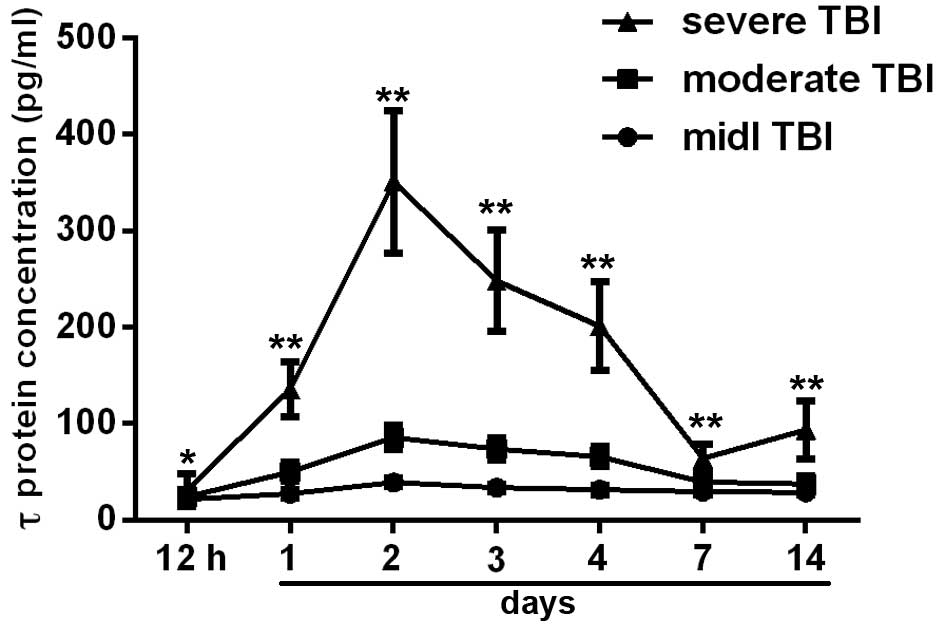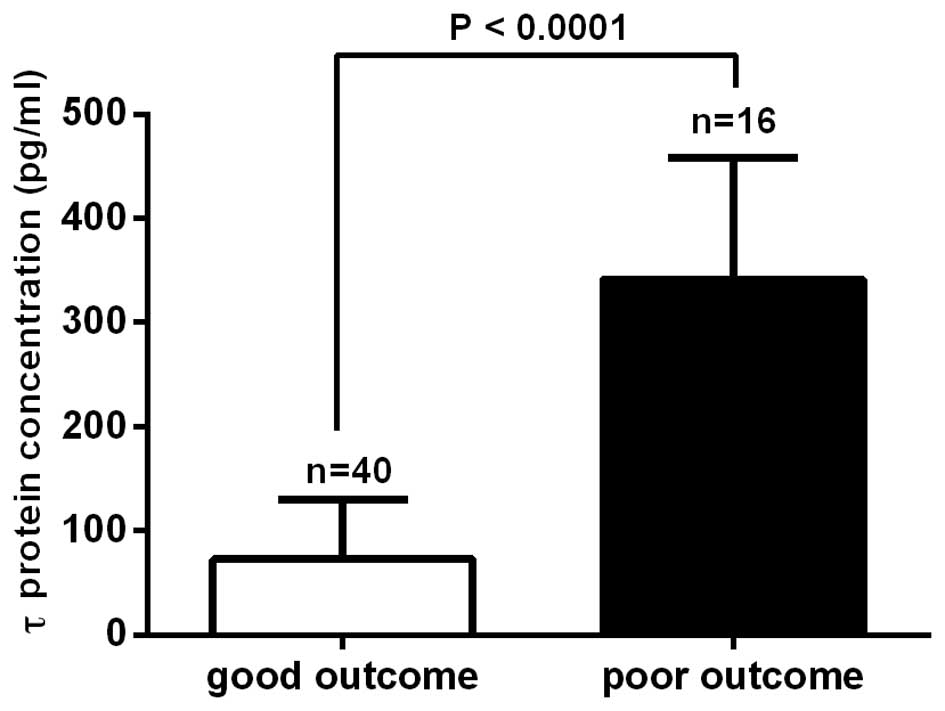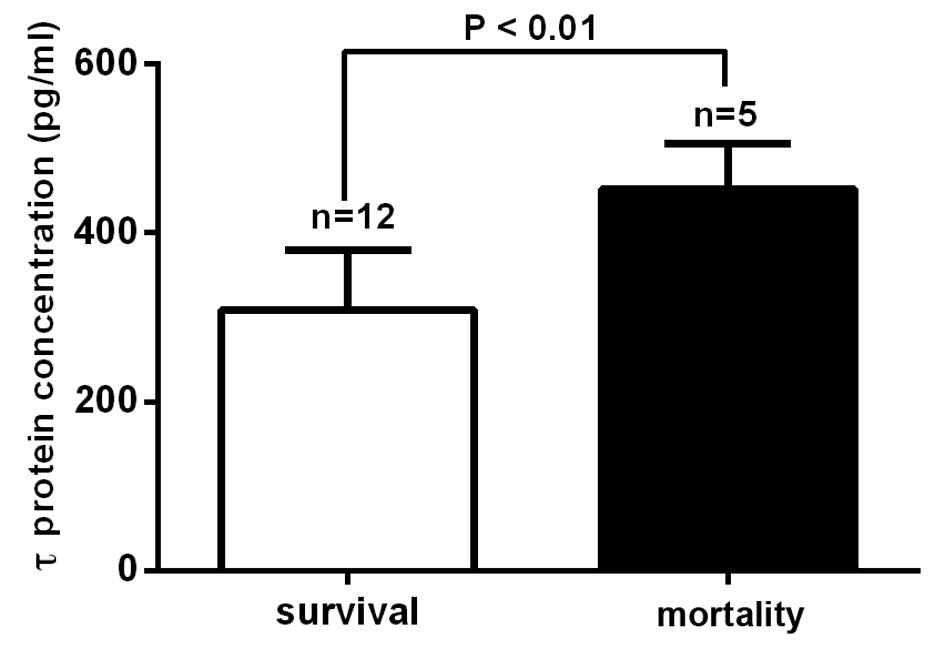Introduction
Traumatic brain injury (TBI) is one of the leading
causes of mortality and disability among all cases of trauma
(1,2). The incidence of TBI in China is
~95/100,000 people per year, which is similar to the incidence of
stroke; however, TBI also affects younger individuals, resulting in
a significant health care burden (3). A wide range of injuries are considered
as TBIs, including mild, moderate and severe injuries (4). At present, the severity of TBI is
typically evaluated by the Glasgow Coma Score (GCS) (4). The GCS characterizes the level of
consciousness on the basis of motor, verbal and eye responses; the
picture provided by these responses enables comparisons between
patients and the assessment of changes in individual patients over
time, and guides the management of these patients (4). The three components (motor, verbal and
eye responses) can be scored separately or combined in a sum score,
which ranges between 3 and 15 (4).
Patients with TBI may be divided into three groups, according to
their GCS scores: Severe TBI (GCS score, 3–8 points); moderate TBI
(GCS score, 9–12 points); and mild TBI (GCS score, 13–15 points)
(4). Certain clinical
characteristics, such as the GCS score and the results of
functional imaging studies, are well established for predicting the
outcome of TBI patients (5).
However, these are not accurate and are difficult to quantify in
order to predict the outcome (5). No
reliable predictors, particularly during the early stages following
TBI, have been established to date. Therefore, it may be beneficial
to establish a complementary approach using specific biochemical
biomarkers in the assessment of TBI patients.
τ protein is a microtubule-associated protein with a
molecular mass of 48–67 kDa (6).
This protein binds to axonal microtubules and results in the
formation of axonal microtubule bundles, which are essential
structural elements in the axonal cytoskeleton (6). τ protein is abundant in the central
nervous system (CNS), and in particular, in unmyelinated axons and
cortical interneurons (6,7). In addition, the τ protein can be
detected in the cerebrospinal fluid (CSF) in the majority of cases,
however, the determination of serum τ protein levels in healthy
individuals is challenging (8). When
damage to axons occurs following TBI, τ protein is released from
the CNS into the CSF and serum, resulting in detectable levels of
the serum protein (9). This suggests
that serum τ protein may be a potential biomarker in the assessment
of the outcome of TBI patients.
Several authors have investigated the CSF τ protein
levels following TBI (10–12); however, the results of these studies
are divergent and conflicting. To the best of our knowledge,
research on serum τ protein in TBI patients has yet to be
conducted. The predictive value of serum τ protein for TBI patients
remains unclear. Therefore, the present study examined the serum τ
protein levels at different time points subsequent to TBI, and
compared the protein levels to the injury severity and 1-year
outcomes of patients. The study attempted to determine whether
serum τ protein levels reflect the injury severity and predict the
outcome of TBI patients.
Patients and methods
Patient population
Ethical approval was obtained from the Wuhan Central
Hospital (Wuhan, China), in accordance with the Helsinki Criteria.
Written informed consent was obtained from all patients. A total of
56 patients (21 females and 35 males; age range, 18–54 years; mean
age, 30.4±8.9 years) with closed TBI (brain tissue was not
exposed), who were admitted to the Department of Neurosurgery at
the Wuhan Central Hospital within 12 h after injury, were enrolled
in the present study between June 2011 and July 2013. TBI had
previously been diagnosed in these patients based on clinical
characteristics, including: i) Complaint of patients; ii) symptoms,
including a headache, vomiting and loss of consciousness; iii) a
physical examination; and iv) imaging, including a computed
tomography scan. Patients were divided into mild, moderate and
severe TBI groups, according to their initial GCSs, which were
determined immediately following admission. A total of 20 patients
formed the mild TBI group (GCS, 13–15 points), 19 patients formed
the moderate TBI group (GCS, 9–12 points) and 17 patients formed
the severe TBI group (GCS, 3–8 points). All patients were managed
according to the international guidelines for TBI management
(13).
Exclusion criteria
The exclusion criteria were as follows: Age of
<18 years or >60 years, admission to the hospital >12 h
after TBI, absence of informed consent, unavailability of blood
sample, and absence of follow-up data. Patients with a history of
neurological disabilities, severe cardiac disease, cervical spinal
cord injury and other severe systemic diseases were also excluded
from the present study.
τ protein analysis
Serum samples were obtained from the TBI patients at
12 h and at 1, 2, 3, 4, 7 and 14 days after TBI. Samples were
collected in 10 ml separator tubes and then centrifuged at 1,000 ×
g for 15 min at 4°C. Subsequently, the serum samples were frozen
and stored at −80°C until further analysis. The τ protein levels in
the serum were measured using the Human τ Proteins Enzyme-Linked
Immunosorbent Assay (ELISA) kit (CSB-E12011h; Cusabio Biotech Co.,
Ltd., Wuhan, China), according to a previous study (14). The minimum detectable concentration
of τ protein was 15.6 pg/ml, according to the manufacturer's
protocol. Prior to analysis of the serum concentration of τ
protein, a standard dilution curve was constructed using standard
solutions provided with the ELISA kit. The dilution curve of the
serum samples was partial to the standard dilution curve, in order
to ensure the accuracy of the measurements.
Outcome assessment
Outcomes were assessed 1 year after TBI. The
outcomes were quantified using the Extended Glasgow Outcome Scale
(GOS-E) (15), and then classified
into the good (GOS-E score, 5–8) and poor (GOS-E score, 1–4)
outcome groups. The information was predominantly collected in the
Outpatient Department at the Wuhan Central Hospital, although
certain patients were interviewed by telephone or mail to identify
their neurological outcome.
Statistical analysis
Data are expressed as the mean ± standard deviation
and were analyzed using the SPSS version 10.0 statistical software
package (SPSS, Inc., Chicago, IL, USA). Mean values in two or more
groups were analyzed using Student's t-test and protected t-test
(one-way analysis of variance). Receiver operating characteristic
(ROC) curves were used to determine the τ protein level that was
able to yield the best sensitivity and specificity for predicting
the patient outcome or mortality. The area under the ROC (AUC) was
calculated using the SPSS software. Statistically significant
differences were determined by P<0.05.
Results
Serum τ protein levels
τ protein is undetectable in the serum of healthy
patients (9). The serum τ protein
levels increased immediately following TBI. At ~2 days post-injury,
the protein levels peaked and then decreased gradually, although,
in the severe TBI group, the serum τ protein levels increased
slightly between days 7 and 14 (Fig.
1). The mean serum τ protein levels on day 2 were 39.14±3.78
pg/ml in the mild TBI group, 85.58±12.72 pg/ml in the moderate TBI
group and 351.02±73.80 pg/ml in the severe TBI group. Statistically
significant differences were found among the three groups
(P<0.05 at 12 h and P<0.0001 at days 2–14, after TBI). Data
regarding the mean serum τ protein levels, patient numbers and
P-values are summarized in Table
I.
 | Table I.Patient data regarding patient
numbers, mean serum τ protein levels and statistical P-values. |
Table I.
Patient data regarding patient
numbers, mean serum τ protein levels and statistical P-values.
|
| Mean serum τ protein
levels in TBI groups, (pg/ml) |
|
|---|
|
|
|
|
|---|
| after TBI | Mild (n=20) | Moderate (n=19) | Severe
(patients) | P-value |
|---|
| 12 h |
21.52±3.82 |
23.79±7.15 |
31.04±16.89
(n=17) | <0.0500 |
| 1 day |
27.44±4.12 |
49.97±9.77 |
135.67±28.91
(n=17) | <0.0001 |
| 2 days |
39.14±3.78 |
85.58±12.72 |
351.02±73.80
(n=17) | <0.0001 |
| 3 days |
33.46±3.90 |
73.56±11.57 |
248.12±52.67
(n=16) | <0.0001 |
| 4 days |
31.55±4.89 |
65.66±10.45 |
201.19±46.46
(n=16) | <0.0001 |
| 7 days |
29.54±3.15 |
39.22±9.28 |
63.96±14.45
(n=14) | <0.0001 |
| 14 days |
28.35±2.69 |
37.44±8.45 |
93.59±29.98
(n=14) | <0.0001 |
Outcome and survival
Outcomes were assessed 1 year after TBI using the
GOS-E. In total, 40 patients were classified into the good outcome
group and 16 patients, including 2 cases in the moderate TBI group
and 14 cases in the severe TBI group, were classified into the poor
outcome group. Subsequently, the mean serum τ protein levels on day
2 post-TBI between these groups were compared. The mean serum τ
protein level was 341.43±29.29 pg/ml for the poor outcome group and
72.85±8.99 pg/ml for the good outcome group. This suggested that
the τ protein level was significantly higher in the poor outcome
group, as compared with the good outcome group (P<0.0001;
Fig. 2). In total, 5 cases of
mortality were observed in the patient cohort of the present study:
1 patient succumbed to the disease on day 3 after TBI, 2 patients
on day 6 and 2 patients within 6 months after discharge from the
hospital. Furthermore, all cases of mortality were patients from
the severe TBI group. A significantly higher mean serum τ protein
level was observed in the mortality cases (452.04±24.23 pg/ml), as
compared with that of cases that survived (309.06±20.55 pg/ml) in
the severe TBI group (P<0.01; Fig.
3).
Sensitivity and specificity
Using ROC curve analysis, a sensitivity of 93.75%
and a specificity of 92.50% were detected for a poor 1-year outcome
when the serum τ protein levels were >116.04 pg/ml on day 2
after TBI. The calculated AUC was 0.9781 [95% confidence interval
(CI), 0.9472–1.009; P<0.0001; Fig.
4A]. Patients from the severe TBI group that succumbed to the
disease had a cut-off level of serum τ protein level on day 2 of
>372.1 pg/ml, with a sensitivity of 100% and specificity of
83.33%, with a calculated AUC of 0.9500 (95% CI, 0.8510–1.049;
P<0.01; Fig. 4B).
 | Figure 4.ROC curve showing the specificity and
sensitivity of serum τ protein levels on day 2 after TBI for (A)
1-year poor outcome (GOS-E, 1–4), and (B) 1-year mortality (GOS-E,
1) in the severe TBI group. The AUC of the outcome curve was 0.9781
(95% CI, 0.9472–1.009; P<0.0001), whereas the AUC of the
mortality rate curve was 0.9500 (95% CI, 0.8510–1.049; P<0.01).
ROC, receiver operating characteristic; TBI, traumatic brain
injury; AUC, area under the curve; GOS-E, Extended Glasgow Outcome
Scale; CI, confidence interval. |
Discussion
Previous studies have employed TBI animal models in
which damaged neurons enter a pathological cascade subsequent to
injury, including cytoskeletal changes resulting in the loss of
microtubule density (16,17). This TBI-induced loss of microtubule
density has been found to be associated with a 45% decrease in the
levels of microtubule-associated proteins in previous
immunochemical studies (18,19). This suggests that
microtubule-associated proteins may serve as potential biomarkers
for TBI. Therefore, the present study investigated the potential of
using τ protein as a biomarker of TBI.
τ protein is a small phosphor protein detected in
the axonal compartments of neurons, which binds with microtubules,
promoting their stability and assembly (20,21).
Human brain τ protein has six isoforms, with a molecular mass of
48–67 kDa, upon sodium dodecyl sulfate-polyacrylamide gel
electrophoresis (22,23). Increased levels of CSF τ protein are
a possible sign of axonal injury and have been reported in
Alzheimer's disease (24). While τ
protein can be measured in the CSF of both healthy and pathological
cases, its detection in the serum of healthy individuals is
difficult (8). However, τ protein
becomes detectable following TBI, since the damage to axons results
in its release from CNS neurons (24). In the clinical field, serum τ protein
has the advantage that it can be measured by less invasive methods
compared with those used to measure CSF τ protein (25). Numerous studies revealed that τ
protein levels are higher in CSF in severe TBI patients, but only a
limited number of studies have investigated the serum τ protein
levels (9,26–28). In
addition, previous studies focused only on severe TBI patients
rather than on the full spectrum of TBI patients, although it has
been reported that serum τ protein levels increased even in mild
TBI patients (19,29). Therefore, the course of serum τ
protein levels subsequent to TBI has not been extensively
studied.
In the present study, the serum τ protein levels in
the full spectrum of TBI patients (mild, moderate and severe cases)
were detected at different time points subsequent to TBI. The
results showed that the serum τ protein levels increased soon after
TBI. Approximately 2 days after the injury, the protein levels
reached a peak value, and then decreased gradually. Between days 7
and 14, there was a slight increase in serum τ protein in the
severe group. This increase may be due to the increase of τ protein
phosphorylation, which was likely caused by secondary cerebral
ischemia damage post-trauma. However, this should be verified in
future studies. In addition, the mean serum τ protein levels were
found to be significantly higher in the severe TBI group, as
compared with those in the mild and moderate groups (severe group
levels > moderate group levels > mild group levels;
P<0.05), which indicated that the serum τ protein levels may
perfectly reflect the severity of TBI.
Certain authors have shown that there is a positive
correlation between high CSF τ protein levels and poor patient
outcome (8,30,31). In
order to determine whether there was also a positive correlation
between serum τ protein levels and patient outcome, the present
study compared the serum τ protein levels in the poor and good
1-year outcome groups. The study focused on the serum τ protein
levels on day 2 after TBI, since day 2 showed the most significant
differences among the three groups and thus was the most
representative. The results demonstrated that the mean serum τ
protein levels on day 2 were significantly higher in the poor
outcome group compared with those in the good outcome group. An ROC
curve analysis evaluating the ability of serum τ protein levels to
predict poor outcome showed an AUC value of 0.9781, with a 93.75%
sensitivity and 92.50% specificity when the τ protein level was
>116.04 pg/ml on day 2 after TBI. Furthermore, the current study
detected a sensitivity of 100% and a specificity of 83.33% for
1-year mortality when the serum τ protein level on day 2 was
>372.1 pg/ml.
In conclusion, the study clearly showed the early
dynamic course of serum τ protein levels following TBI. The mean
serum τ protein levels were significantly higher in the severe TBI
group compared with those in the mild and moderate group. In
addition, a positive correlation was observed between high serum τ
protein levels and poor outcome in TBI patients. Therefore, the
findings of the current study suggest that serum τ protein may
serve as a potential biomarker used to evaluate the severity and
predict the outcome of TBI patients.
Acknowledgements
The present study was partially supported by grants
from the National Natural Science Foundation of China (grant no.
81101620) and Clinical Project of Wuhan Health Bureau (grant no.
WX14B08). Mr. Junwen Wang would like to thank Miss. Shunying Liu
(Wuhan Central Hospital) for her great support in this study.
References
|
1
|
Chiu WT, Huang SJ, Tsai SH, Lin JW, Tsai
MD, Lin TJ and Huang WC: The impact of time, legislation, and
geography on the epidemiology of traumatic brain injury. J Clin
Neurosci. 14:930–935. 2007. View Article : Google Scholar : PubMed/NCBI
|
|
2
|
Lin JW, Tsai SH, Tsai WC, Chiu WT, Chu SF,
Lin CM, Yang CM and Hung CC: Survey of traumatic intracranial
hemorrhage in Taiwan. Surgical Neurol. 66(Suppl 2): S20–S25. 2006.
View Article : Google Scholar
|
|
3
|
Marklund N, Blennow K, Zetterberg H,
Ronne-Engström E, Enblad P and Hillered L: Monitoring of brain
interstitial total tau and beta amyloid proteins by microdialysis
in patients with traumatic brain injury. J Neurosurg.
110:1227–1237. 2009. View Article : Google Scholar : PubMed/NCBI
|
|
4
|
Teasdale G and Jennett B: Assessment of
coma and impaired consciousness. A practical scale. Lancet.
2:81–84. 1974. View Article : Google Scholar : PubMed/NCBI
|
|
5
|
Pedersen AR, Severinsen K and Nielsen JF:
The effect of age on rehabilitation outcome after traumatic brain
injury assessed by the Functional Independence Measure (FIM).
Neurorehabil Neural Repair. 29:299–307. 2015. View Article : Google Scholar : PubMed/NCBI
|
|
6
|
Buee L, Bussière T, Buée-Scherrer V,
Delacourte A and Hof PR: Tau protein isoforms, phosphorylation and
role in neurodegenerative disorders. Brain Res Brain Res Rev.
33:95–130. 2000. View Article : Google Scholar : PubMed/NCBI
|
|
7
|
Goedert M, Spillantini MG, Cairns NJ and
Crowther RA: Tau proteins of Alzheimer paired helical filaments:
Abnormal phosphorylation of all six brain isoforms. Neuron.
8:159–168. 1992. View Article : Google Scholar : PubMed/NCBI
|
|
8
|
Ost M, Nylén K, Csajbok L, Ohrfelt AO,
Tullberg M, Wikkelsö C, Nellgård P, Rosengren L, Blennow K and
Nellgård B: Initial CSF total tau correlates with 1-year outcome in
patients with traumatic brain injury. Neurology. 67:1600–1604.
2006. View Article : Google Scholar : PubMed/NCBI
|
|
9
|
Takahashi K, Hasegawa S, Maeba S, Fukunaga
S, Motoyama M, Hamano H and Ichiyama T: Serum tau protein level
serves as a predictive factor for neurological prognosis in
neonatal asphyxia. Brain Dev. 36:670–675. 2014. View Article : Google Scholar : PubMed/NCBI
|
|
10
|
Amadoro G, Corsetti V, Sancesario GM,
Lubrano A, Melchiorri G, Bernardini S, Calissano P and Sancesario
G: Cerebrospinal fluid levels of a 20–22 kDa NH2 fragment of human
tau provide a novel neuronal injury biomarker in Alzheimer's
disease and other dementias. J Alzheimers Dis. 42:211–226.
2014.PubMed/NCBI
|
|
11
|
Clarke NA, Hartmann T, Jones EL, Ballard
CG and Francis PT: Antipsychotic medication is associated with
selective alterations in ventricular cerebrospinal fluid Abeta 40
and tau in patients with intractable unipolar depression. Int J
Geriatr Psychiatry. 26:1283–1291. 2011. View Article : Google Scholar : PubMed/NCBI
|
|
12
|
Hulstaert F, Blennow K, Ivanoiu A,
Schoonderwaldt HC, Riemenschneider M, De Deyn PP, Bancher C, Cras
P, Wiltfang J, Mehta PD, et al: Improved discrimination of AD
patients using beta-amyloid (1-42) and tau levels in CSF.
Neurology. 52:1555–1562. 1999. View Article : Google Scholar : PubMed/NCBI
|
|
13
|
Brain Trauma Foundation; American
Association of Neurological Surgeons, Joint Section on Neurotrauma
and Critical Care: Management and Prognosis of Severe Traumatic
Brain Injury. Brain Trauma Foundation (New York, NY, USA).
4492000.
|
|
14
|
Blennow K and Fredman P: Detection of
cerebrospinal fluid leakage by isoelectric focusing on
polyacrylamide gels with silver staining using the PhastSystem.
Acta Neurochir (Wien). 136:135–139. 1995. View Article : Google Scholar : PubMed/NCBI
|
|
15
|
Wilson JT, Pettigrew LE and Teasdale GM:
Structured interviews for the Glasgow Outcome Scale and the
extended Glasgow Outcome Scale: Guidelines for their use. J
Neurotrauma. 15:573–585. 1998. View Article : Google Scholar : PubMed/NCBI
|
|
16
|
Maxwell WL, Donnelly S, Sun X, Fenton T,
Puri N and Graham DI: Axonal cytoskeletal responses to
nondisruptive axonal injury and the short-term effects of
posttraumatic hypothermia. J Neurotrauma. 16:1225–1234. 1999.
View Article : Google Scholar : PubMed/NCBI
|
|
17
|
Pettus EH and Povlishock JT:
Characterization of a distinct set of intra-axonal ultrastructural
Changes associated with traumatically induced alteration in
axolemmal permeability. Brain Res. 722:1–11. 1996. View Article : Google Scholar : PubMed/NCBI
|
|
18
|
Posmantur RM, Kampfl A, Liu SJ, Heck K,
Taft WC, Clifton GL and Hayes RL: Cytoskeletal derangements of
cortical neuronal processes three hours after traumatic brain
injury in rats: An immunofluorescence study. J Neuropathol Exp
Neurol. 55:68–80. 1996. View Article : Google Scholar : PubMed/NCBI
|
|
19
|
Taft WC, Yang K, Dixon CE and Hayes RL:
Microtubule-associated protein 2 levels decrease in hippocampus
following traumatic brain injury. J Neurotrauma. 9:281–290. 1992.
View Article : Google Scholar : PubMed/NCBI
|
|
20
|
Vos PE, Lamers KJ, Hendriks JC, van Haaren
M, Beems T, Zimmerman C, van Geel W, de Reus H, Biert J and Verbeek
MM: Glial and neuronal proteins in serum predict outcome after
severe traumatic brain injury. Neurology. 62:1303–1310. 2004.
View Article : Google Scholar : PubMed/NCBI
|
|
21
|
Zanier ER, Zoerle T, Fiorini M, Longhi L,
Cracco L, Bersano A, Branca V, Benedetti MD, De Simoni MG, Monaco S
and Stocchetti N: Heart-fatty acid-binding and tau proteins relate
to brain injury severity and long-term outcome in subarachnoid
haemorrhage patients. Br J Anaesth. 111:424–432. 2013. View Article : Google Scholar : PubMed/NCBI
|
|
22
|
Huber BR, Meabon JS, Martin TJ, Mourad PD,
Bennett R, Kraemer BC, Cernak I, Petrie EC, Emery MJ, Swenson ER,
et al: Blast exposure causes early and persistent aberrant phospho-
and cleaved-tau expression in a murine model of mild blast-induced
traumatic brain injury. J Alzheimers Dis. 37:309–323.
2013.PubMed/NCBI
|
|
23
|
Neher MD, Keene CN, Rich MC, Moore HB and
Stahel PF: Serum biomarkers for traumatic brain injury. South Med
J. 107:248–255. 2014. View Article : Google Scholar : PubMed/NCBI
|
|
24
|
Vandermeeren M, Mercken M, Vanmechelen E,
Six J, van de Voorde A, Martin JJ and Cras P: Detection of tau
proteins in normal and Alzheimer's disease cerebrospinal fluid with
a sensitive sandwich enzyme-linked immunosorbent assay. J
Neurochem. 61:1828–1834. 1993. View Article : Google Scholar : PubMed/NCBI
|
|
25
|
Liliang PC, Liang CL, Lu K, Wang KW, Weng
HC, Hsieh CH, Tsai YD and Chen HJ: Relationship between injury
severity and serum tau protein levels in traumatic brain injured
rats. Resuscitation. 81:1205–1208. 2010. View Article : Google Scholar : PubMed/NCBI
|
|
26
|
Shiihara T, Miyake T, Izumi S, Sugihara S,
Watanabe M, Takanashi J, Kubota M and Kato M: Serum and CSF
biomarkers in acute pediatric neurological disorders. Brain Dev.
36:489–495. 2014. View Article : Google Scholar : PubMed/NCBI
|
|
27
|
Shahim P, Tegner Y, Wilson DH, Randall J,
Skillbäck T, Pazooki D, Kallberg B, Blennow K and Zetterberg H:
Blood biomarkers for brain injury in concussed professional ice
hockey players. JAMA Neurol. 71:684–692. 2014. View Article : Google Scholar : PubMed/NCBI
|
|
28
|
Zemlan FP, Jauch EC, Mulchahey JJ, Gabbita
SP, Rosenberg WS, Speciale SG and Zuccarello M: C-tau biomarker of
neuronal damage in severe brain injured patients: Association with
elevated intracranial pressure and clinical outcome. Brain Res.
947:131–139. 2002. View Article : Google Scholar : PubMed/NCBI
|
|
29
|
Guzel A, Karasalihoglu S, Aylanç H,
Temizöz O and Hiçdönmez T: Validity of serum tau protein levels in
pediatric patients with minor head trauma. Am J Emerg Med.
28:399–403. 2010. View Article : Google Scholar : PubMed/NCBI
|
|
30
|
Rubenstein R, Chang B, Davies P, Wagner
AK, Robertson CS and Wang KK: A Novel, ultrasensitive assay for
tau: Potential for assessing traumatic brain injury in tissues and
biofluids. J Neurotrauma. 32:342–352. 2015. View Article : Google Scholar : PubMed/NCBI
|
|
31
|
Zhang ZY, Zhang LX, Dong XQ, Yu WH, Du Q,
Yang DB, Shen YF, Wang H, Zhu Q, Che ZH, et al: Comparison of the
performances of copeptin and multiple biomarkers in long-term
prognosis of severe traumatic brain injury. Peptides. 60:13–17.
2014. View Article : Google Scholar : PubMed/NCBI
|


















